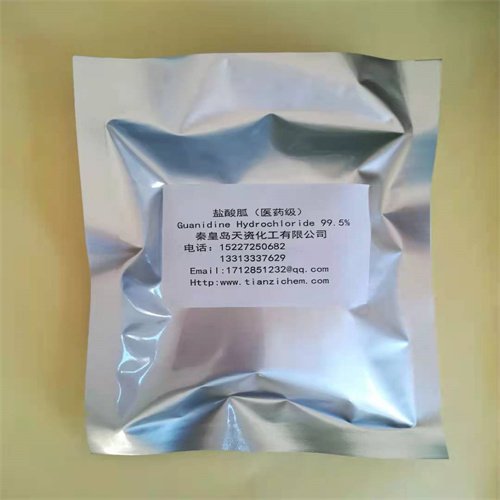
- English
- Español
- Português
- русский
- Français
- 日本語
- Deutsch
- tiếng Việt
- Italiano
- Nederlands
- ภาษาไทย
- Polski
- 한국어
- Svenska
- magyar
- Malay
- বাংলা ভাষার
- Dansk
- Suomi
- हिन्दी
- Pilipino
- Türkçe
- Gaeilge
- العربية
- Indonesia
- Norsk
- تمل
- český
- ελληνικά
- український
- Javanese
- فارسی
- தமிழ்
- తెలుగు
- नेपाली
- Burmese
- български
- ລາວ
- Latine
- Қазақша
- Euskal
- Azərbaycan
- Slovenský jazyk
- Македонски
- Lietuvos
- Eesti Keel
- Română
- Slovenski
- मराठी
- Srpski језик
The role of guanidine hydrochloride nucleic acid detection reagent raw materials
2021-11-26
The principle of new coronavirus nucleic acid detection is to expose the viral RNA through cell lysate, and then use real-time fluorescent RT-PCR for detection. Because the new coronavirus is very contagious, in order to protect testers and reduce the risk of infection, the virus needs to be inactivated.
Virus inactivation means that the virus protein no longer has physiological activity and loses the ability to infect, cause disease and reproduce. The main method is high temperature inactivation in a water bath, that is, the sample is placed in a water bath and inactivated at a high temperature of 56°C for half an hour. In addition, some nucleic acid detection kits come with virus inactivation preservation solution, which can "kill" the virus and protect RNA during the sample collection stage.
This virus preservation solution, also called virus sampling solution, is prepared based on nucleic acid extraction and lysis solution. The main ingredients are
Balanced salts, EDTA chelating agents, guanidine salts (such as guanidine isothiocyanate, guanidine hydrochloride, etc.), anionic surfactants (such as sodium lauryl sulfate), cationic surfactants (such as tetradecyl trimethyl Ammonium oxalate), phenol, 8-hydroxyquinoline, dithiothreitol (DTT), proteinase K, etc. [1].
Because it is prepared based on the calculation of the lysate, the role of guanidine hydrochloride, EDTA, DTT and other reagents in this virus preservation solution is the same as that of the nucleic acid extraction described earlier [2]. Guanidine hydrochloride can not only destroy cell membranes quickly, but also denature proteins, so that proteins can be denatured and precipitated, so that nucleic acids can get rid of the entanglement of proteins. EDTA chelating agent can combine with metal ions such as Mg2+, Ca2+, Mn2+, Fe2+, and reduce the influence of metal ions on the quality of nucleic acid. DTT is often used as a disulfide bond reducing agent to prevent delaying enzyme inactivation.
On the one hand, this virus preservation solution directly lyses the virus to release nucleic acid and eliminates nucleic acid decomposing enzyme (RNase) to prevent virus RNA degradation. On the other hand, it can denature the protein of the virus, lose its activity and "dead", no longer be infectious, and improve the safety of the transportation and detection stage.

Virus inactivation means that the virus protein no longer has physiological activity and loses the ability to infect, cause disease and reproduce. The main method is high temperature inactivation in a water bath, that is, the sample is placed in a water bath and inactivated at a high temperature of 56°C for half an hour. In addition, some nucleic acid detection kits come with virus inactivation preservation solution, which can "kill" the virus and protect RNA during the sample collection stage.
This virus preservation solution, also called virus sampling solution, is prepared based on nucleic acid extraction and lysis solution. The main ingredients are
Balanced salts, EDTA chelating agents, guanidine salts (such as guanidine isothiocyanate, guanidine hydrochloride, etc.), anionic surfactants (such as sodium lauryl sulfate), cationic surfactants (such as tetradecyl trimethyl Ammonium oxalate), phenol, 8-hydroxyquinoline, dithiothreitol (DTT), proteinase K, etc. [1].
Because it is prepared based on the calculation of the lysate, the role of guanidine hydrochloride, EDTA, DTT and other reagents in this virus preservation solution is the same as that of the nucleic acid extraction described earlier [2]. Guanidine hydrochloride can not only destroy cell membranes quickly, but also denature proteins, so that proteins can be denatured and precipitated, so that nucleic acids can get rid of the entanglement of proteins. EDTA chelating agent can combine with metal ions such as Mg2+, Ca2+, Mn2+, Fe2+, and reduce the influence of metal ions on the quality of nucleic acid. DTT is often used as a disulfide bond reducing agent to prevent delaying enzyme inactivation.
On the one hand, this virus preservation solution directly lyses the virus to release nucleic acid and eliminates nucleic acid decomposing enzyme (RNase) to prevent virus RNA degradation. On the other hand, it can denature the protein of the virus, lose its activity and "dead", no longer be infectious, and improve the safety of the transportation and detection stage.




